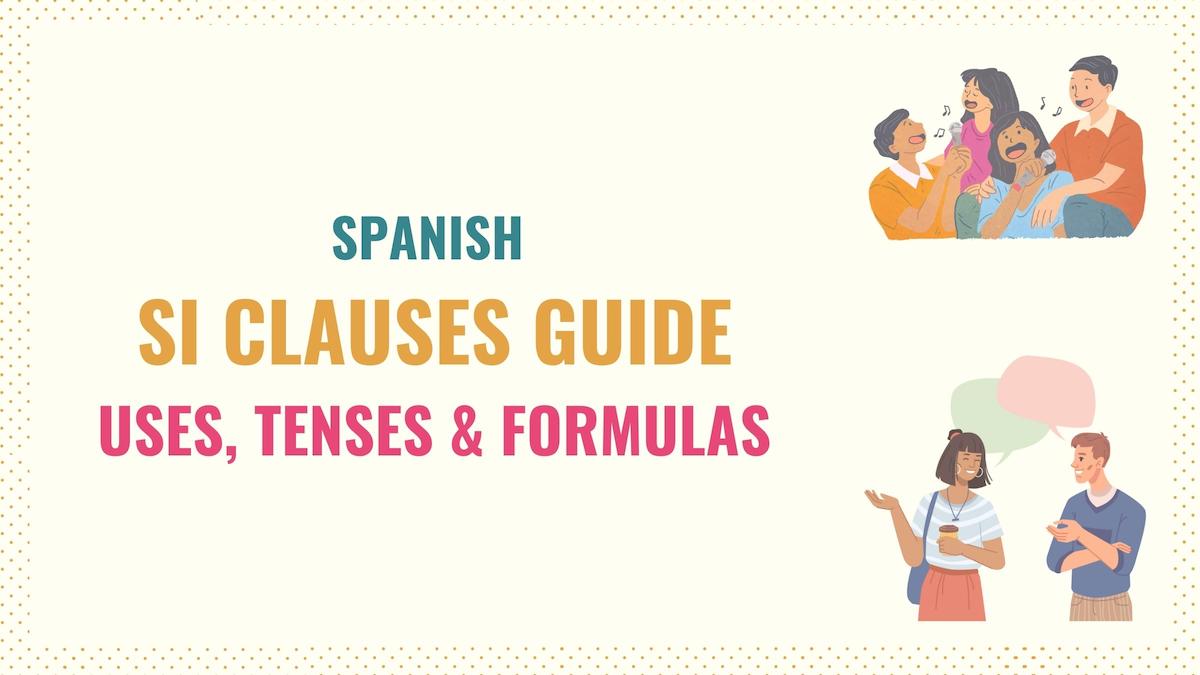Si clauses are an essential component of Spanish since they allow you to create conditional statements. In short, this is a topic you can’t afford to overlook. Seeing how common and crucial these structures are for daily communication, in this si clauses Spanish guide, we’ll go over:
I’ve included real-life examples and charts to make this topic as easy and understandable as possible. Let’s start.
What Are Spanish Si Clauses?
Spanish si clauses are sentence structures used to express a condition and its potential consequences. For instance:
Si + [conjugated verb] + [outcome]
Si quieres, te llamo más tarde.
If you want, I can call you later.
No van a salir si no terminan su tarea.
You aren’t going out if you don’t finish your homework.
Notice that when it comes to these sentences, the order of the elements is flexible.
As you can see in the examples above, si clauses are conditional statements. Since they express what happens if some circumstances are met, they relate to hypothetical situations.
In Spanish, si clauses are dependent clauses that cannot stand alone. To make sense, these sentences must be accompanied by a main clause –the verb describing the consequence or result.
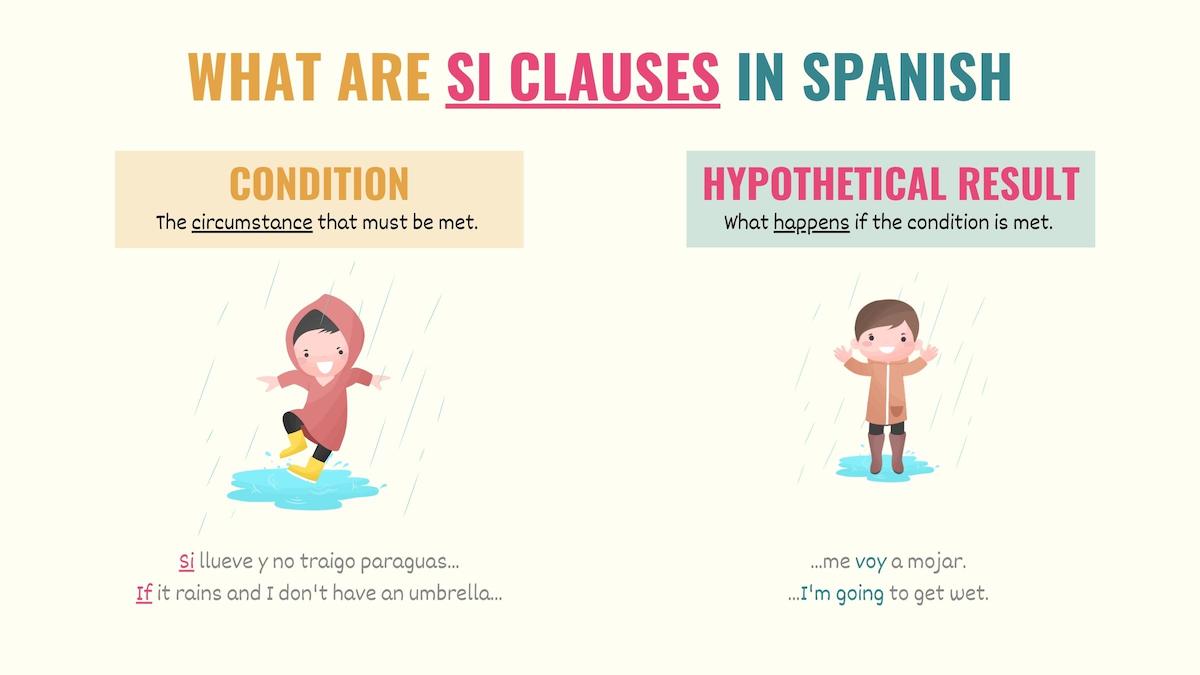
Although most people assume that si + verb conjugated is the only way to form si clauses, there are some words you can add to this formula to sound more natural:
- Como si: As if
- Incluso si: Even if
- Por si: In case
- Si acaso: In case
Llévate un suéter por si llueve.
Take a sweater in case it rains.
Take Note: Do not confuse the word si (unaccented) with the affirmative word sí (accent). The word si is a Spanish conjunction used to form conditional statements. These structures are the equivalent of if clauses in English.
Si Clauses Spanish Chart & Types
As mentioned above, if clauses in Spanish express hypothetical circumstances we must meet to reach a specific outcome. However, it’s important to note that not all conditions are realistic.
Si clauses are combined with different Spanish tenses to express the likelihood of meeting a condition. Based on how achievable and realistic they’re, if clauses are classified into:
- First conditional (likely)
- Second conditional (unlikely)
- Third conditional (impossible)
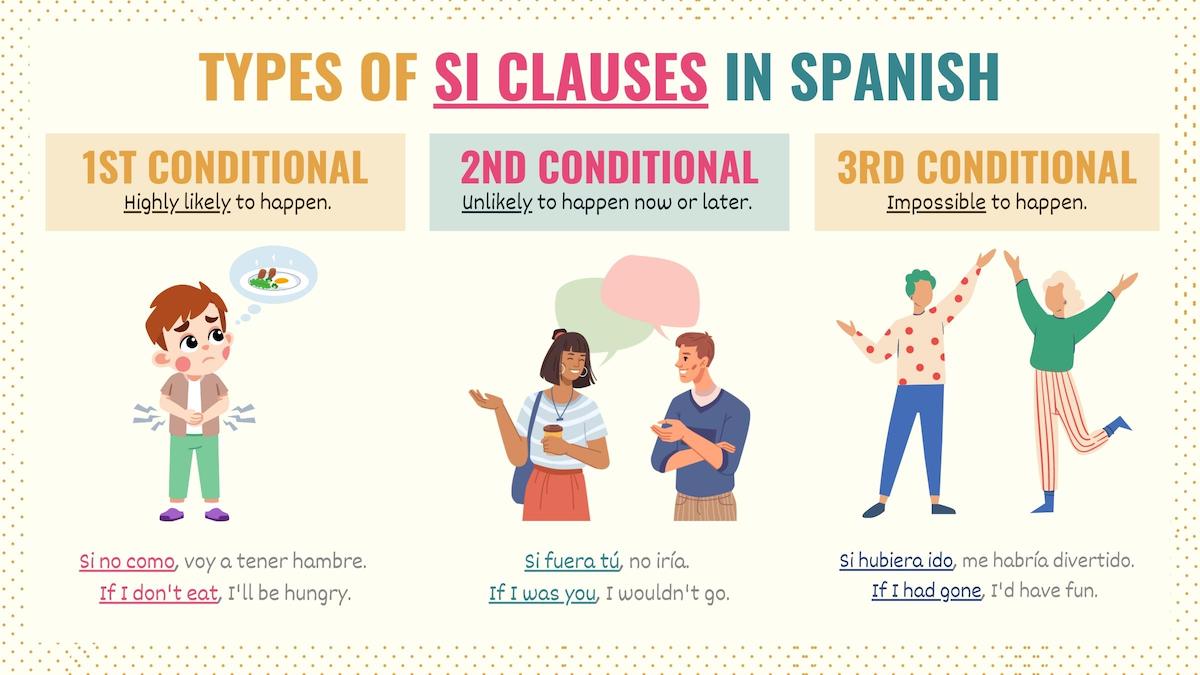
Spanish first conditional
The first type of si clause refers to realistic conditions. In other words, circumstances that are highly likely to happen and which consequences come true in the present or future. With the first conditional in Spanish, si clauses are conjugated in the present tense.
Here are the formulas for this conditional:
- Outcomes that come true in the present: si + present + present
- Results that will happen in the future: si + present + future
- Suggestions, orders, or instructions in the present: si + present + imperative
Check these examples:
Si + [present tense verb] + [verb in present, future or imperative]
Si tengo tiempo, yo la llevo.
If I have time, I will take her.
Si está lloviendo, no vamos a ir.
If it’s raining, we are not going.
Si nos quedamos dormidos, llegaremos tarde.
If we fall asleep, we will be late.
Si quieres mejorar tu español, practica más.
If you want to improve your Spanish, practice more.
The circumstances and results mentioned in the previous sentences are realistic and within reach. In fact, these are logical outcomes.
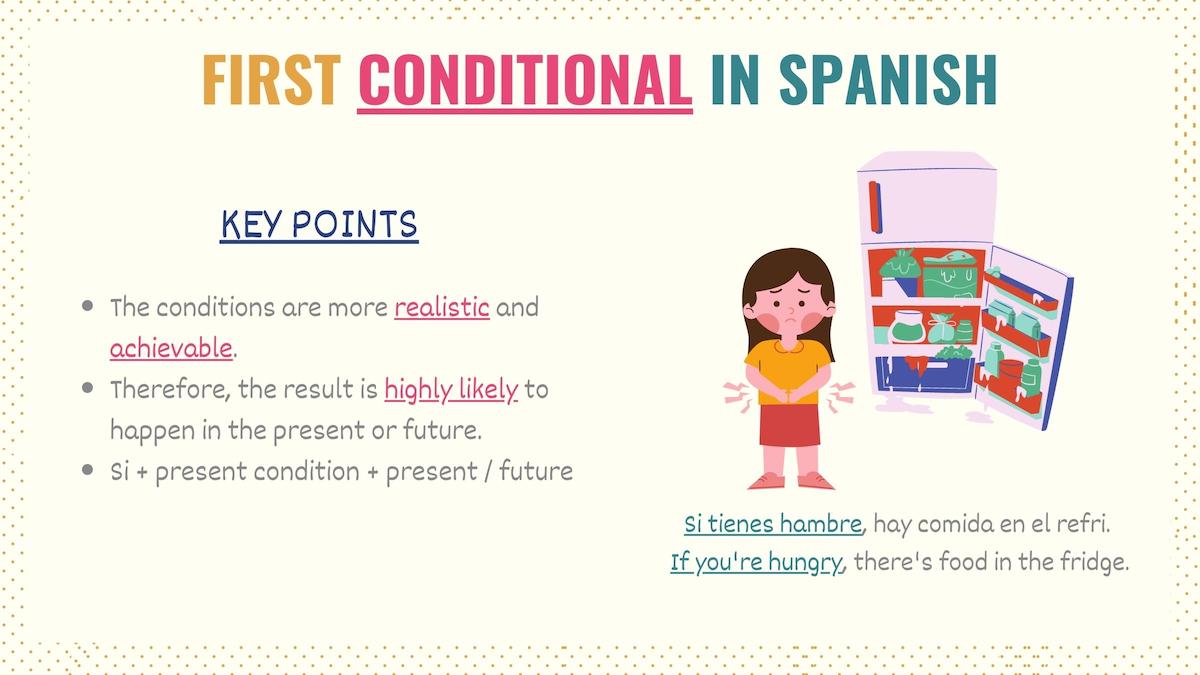
Second conditional
The second type of si clauses in Spanish refers to conditions unlikely to occur in the present or the future. Simply put, such circumstances are not currently true, and it’s more probable they stay that way.
To form this conditional, you must use:
Si + [imperfect subjunctive] + [conditional simple]
Si ganara la lotería, dejaría de trabajar.
If I won the lottery, I would stop working.
¿Te casarías con John si te propusiera matrimonio?
Would you marry John if he proposed?
Si fueras más amable, le caerías mejor a la gente.
If you were nice, people would like you better.
Take sentence #1 as an example. So far, I haven’t won the lottery; honestly, it’s a far-fetched dream. Because the hypothetical circumstance hasn’t happened, and it seems it never will, I must use the second conditional to express the potential results.
Take Note: As a tip, you can think about this type of si clause, as a daydreamer. With these sentences, the speaker imagines an outcome that is not based on current reality.
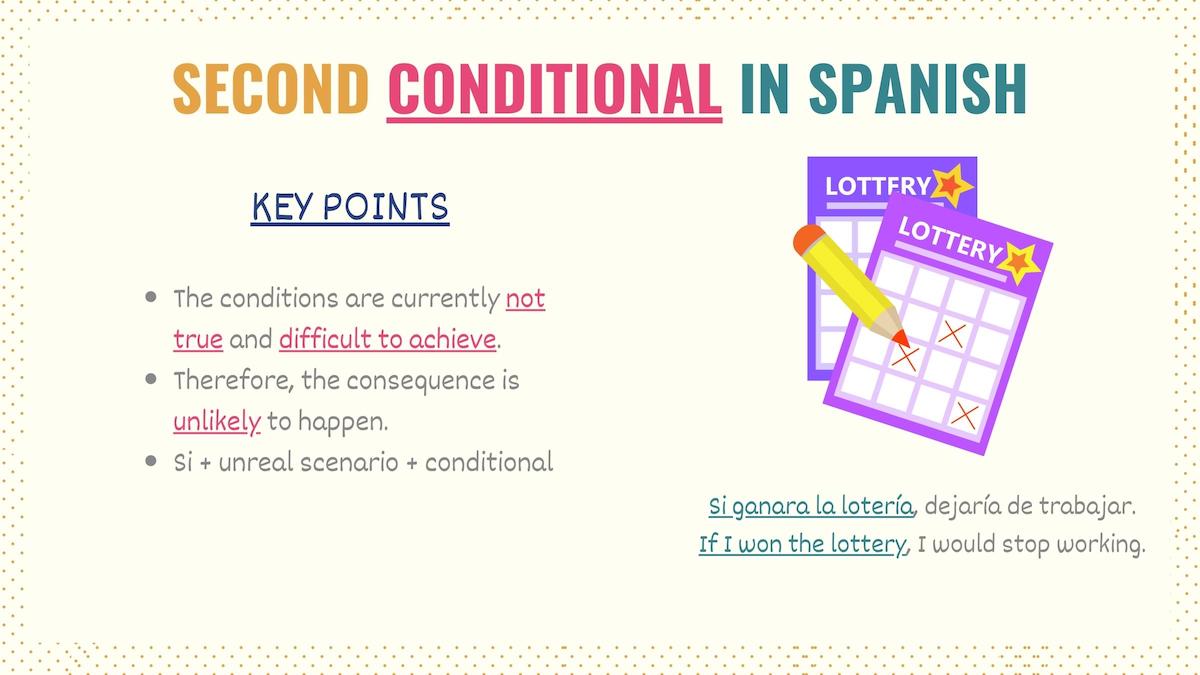
Third conditional in Spanish
The third type of if clause in Spanish is the third conditional. This structure refers to past conditions that were not fulfilled and expresses the hypothetical results had those circumstances been met.
Because they’re impossible to come true, these si clauses are used to express remorse or disappointment about the past:
Si + [past perfect subjunctive] + [conditional perfect]
No nos habríamos perdido si hubiéramos usado el mapa.
We wouldn’t have gotten lost if we had used the map.
Si me hubieras escuchado, nada de esto habría pasado.
If you had listened to me, none of this would have happened.
With this type of conditional, it’s common to use the past perfect subjunctive tense instead of the conditional perfect to express the hypothetical result:
Si + [past perfect subjunctive] + [past perfect subjunctive]
Si hubieran abierto la tienda, hubiera comprado un pastel.
If they had opened the store, I would have bought a cake.
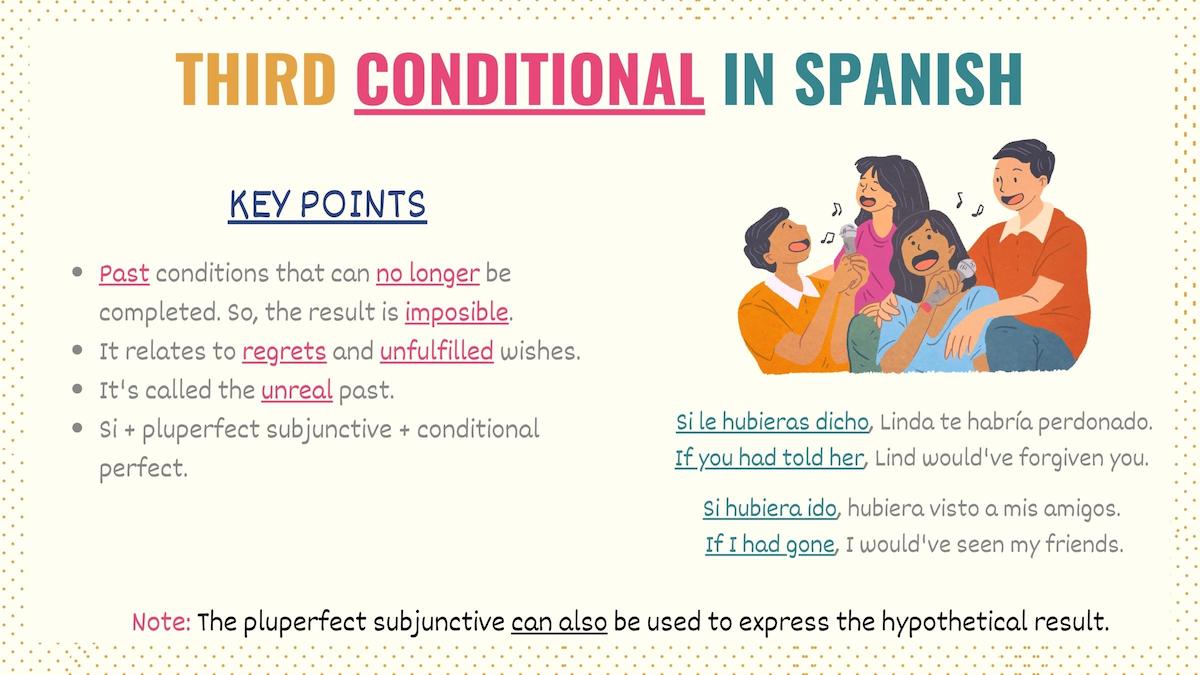
Take Note: The 3rd conditional is also called the “unreal past” because it expresses the potential outcome of things that never happened. Think about this conditional as a missed opportunity.
Key Points
Whether you are a beginner or an advanced learner, Spanish si clauses are key structures that help you communicate outcomes that depend on a condition. Depending on how reachable a condition is, there are different types of si clauses.
Here is a summary:
| Type of Conditional | Si clause formula | Likelihood |
|---|---|---|
| First conditional | Si + present + present | Likely (present results) |
| First conditional | Si + present + future | Likely (future results) |
| First conditional | Si + present + imperative | Likely (present suggestions) |
| Second conditional | Si + imperfect subjunctive + conditional simple | Unreal and unlikely to happen (daydreaming). |
| Third conditional | Si + past perfect subjunctive + conditional perfect Si + past perfect subjunctive + pluperfect subjunctive | Impossible. The past cannot be changed. |
If you ready to test your knowledge, you should take this si clauses practice quiz.
If Clauses Spanish Additional Resources
To use si clauses properly, you should get familiar with the tenses they use. Here is a quick reminder of the topics you may want to check:
- Si Clauses Quiz
- Present Indicative in Spanish
- Future Simple Tense
- Spanish Conditional Simple
- Conditional Perfect Tense
- Past Perfect Subjunctive in Spanish
- Spanish Commands (Imperative)
Download the Si Clauses PDF
Click the button below to download a free copy of the PDF for this guide. It contains all the graphics, comparison chart and explanations of how to use si clauses and the three types in Spanish.

